Wireless Engine TWE-001
"Long Battery Life", "Super low" power consumption & long signal range ZigBee Module TWE-001
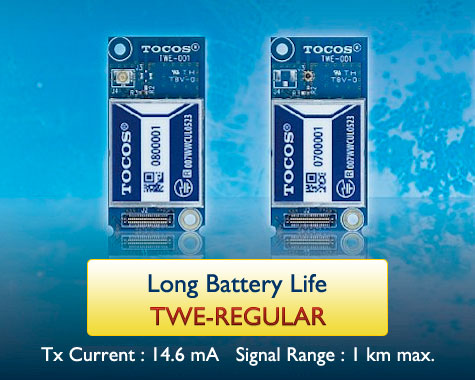
- TWE-001 Brochure (PDF) Japanese version English version
- TWE-001 Data Sheet (PDF) TWD-PDS-TWE001-EN-10.pdf
The product is designed to meet the instantaneous start-up, super low power consumption, and long signal range required for ZigBee / IEEE802.15.4 wireless modules at a high level. TOCOS Wireless Engine TWE-001 is an ZigBee / IEEE802.15.4 module that has been developed featuring especially the super low power consumption performance.
The TOCOS Wireless Engine TWE-001 boasts the world' s lowest level of current consumption (Tx Current: 14.6 mA, Rx Current: 17.2 mA, Standby Current: 1.3 µA) as a wireless microcomputer module compliant with ZigBee/IEEE802.15.4 While working at just a small amount of current, it achieves an amazingly extended signal range of up to 1 km (* 1). The ZigBee/IEEE802.15.4 compliant wireless module satisfies both needs for lower power consumption and longer signal range. The feature of super low power consumption helps batteries for driving the system last longer. The system powered with AC power supply can also keep the electricity consumption low, allowing you to establish an environmentally friendly system. The wireless module has successfully saved a lot of electricity consumed, which is the primary feature of ZigBee/IEEE802.15.4.
As the ZigBee/IEEE802.15.4 Module TWE-001 has various built-in I/Os in one small package such as 32-bit RISC processor of low power consumption and high performance, 12-bit AD converter (4 channels), 12-bit DA converter (2 channels), comparator, pulse counter, and general-purpose digital I/O ports, it allows for direct control of sensors, display, LED, switches and so on. The substantial capacity of RAM and flash memory also allows for stress-free installation of applications that use ZigBee PRO, RF4CE, JenNet and other communications protocols as well.
The ZigBee/IEEE802.15.4 Module TWE-001 has integrated in a wireless module a high-performance PCB pattern antenna which has been designed with cutting-edge technologies and the signal range extends as far as 400 m at line of sight. With an external antenna (2 dBi gain, non-directional) connected to the connector on the wireless module, the line of sight reach will be 1 km at the maximum. (Using a directional antenna of higher gain can make the signal range even longer.)
As this product has already obtained certification according to the Radio Act of Japan, the ARIB STD-T66 Factory Design Certificate (Technical Regulations Conformity Certification), which is required for the use in Japan, you can start selling them just by incorporating it into your product. You can save the time and money of obtaining the certification. The certification is not limited to any specific firmware, so you do not have to obtain new certification even when you use original firmware created on your side. When using the product, also see Considerations about the Radio Act of Japan.
※ For the status of obtaining certification in other countries, please contact us.
We have an excellent quality control system in place so that a customer feels free to use our products even in the industrial equipment which has to operate in a harsh environment.
This is a RoHS-compliant and environmentally friendly product. We can also make the documentation on various environmental regulations (JAMP-AIS, REACH etc.) available on request.
*1: When measured with a non-directional external antenna of 2 dBi gain, with little impact of extraneous noises, at line of sight distance.
Features
"Super low" power consumption
ZigBee/IEEE802.15.4 Module TOCOS Wireless Engine TWE-001 operates at low current consumption (Tx Current: 14.6 mA, Rx Current: 17.2 mA, Standby Current: 1.3 µA) thanks to the world' s best standards of power saving design. Powered by batteries, it achieves a long operating time. It can also run for a long time on low-capacity button batteries and even on a small amount of power gained with energy harvesting technologies. Thanks to the low power consumption feature, the TOCOS Wireless Engine TWE-001 can now realize the applications that were difficult to achieve before because of the limitation in power consumption. We have successfully slashed the power consumption by more than half compared to conventional products without sacrificing the signal range.
Instantaneous start-up
The quick start-up is also one of the features of the ZigBee/IEEE802.15.4 Module TOCOS Wireless Engine TWE-001. With the short start-up and processing time, it will not consume any excessive electricity.
Long Signal Range
In the past, the ZigBee/IEEE802.15.4 Module was considered exclusive for near field communications, with the signal range of several tens of meters to 100 meters at the best. With such a short signal range, we had to use many repeaters as the reach would be even shorter in the environment affected by obstacles or noise. The increased number of repeaters augmented the background communications to sustain the network, which made the communications unstable. Therefore, developing a system design was extremely difficult. In addition, if you tried to amplify the output using power amplifiers in a bid to extend the signal range, then you would end up having higher power consumption. All those things combined caused misunderstanding that the ZigBee/IEEE802.15.4 did not have great reach. To overcome the challenge, the ZigBee/IEEE802.15.4 Wireless Module TWE-001 has been developed with the view to realizing both low power consumption and long signal range. As a result, while maintaining low power consumption, we have secured enough link budget (the budget for connecting communications) that enables long signal range of up to 400 m at line of sight with a built-in antenna, and 1 km with an external antenna (2 dBi gain, non-directional). Using a directional antenna of higher gain can make the signal range even longer. The extended reach will open up the possibility for new applications. Furthermore, you do not have to give up having great reach any more, where you had to because of the limitation in power consumption. Even if you do not need great reach, large link budget will be effective for stable communications in the environment where there are obstacles, e.g. walls. If you do not want the extended signal range, you can attenuate the output in the interval of about -12 db with software control to reduce the signal range.
(* The attenuation of the output will not make the power consumption smaller.)
High-speed communications mode
In addition to the 250 kbps, which is compliant with IEEE802.15.4, it can be switched to the turbo mode of 500/667 kbps, our original standard. Using the turbo mode will achieve further power saving as the data transfer time is shortened. Switching to the high-speed communications mode will not change the power consumption. (When using the high-speed mode, the receiving sensitivity will drop by about 2 dB, which may shorten the signal range.)
Distance measurement
In addition to the distance measurement method using radio waves intensity (RSSI), the ZigBee/IEEE802.15.4 Module TWE-001 has incorporated the time of flight (ToF), the distance measurement function which produces almost constant error against the measured distance by round-trip time of radio waves. With the measurement using radio waves, the distance between 2 points of wireless modules can be obtained. By obtaining the distance information at multiple points, it can be used for two-dimensional and three-dimensional position detection. (The measurement error when using ToF is about ±10 m regardless of the distance.)
Protocol stack
The standard protocol stacks of ZigBee PRO, RF4CE, and JenNet are available without any loyalty. All you need to do is download them in the ZigBee/IEEE802.15.4 Wireless Module TWE-001. The ZigBee PRO, RF4CE, and JenNet protocol stacks have been developed by NXP (Jennic). It is also possible to implement an original protocol stack on IEEE802.15.4 instead of using a standard protocol stack.
32-bit high performance CPU and large capacity memory
The 32-bit RISC CPU built in the ZigBee/IEEE802.15.4 Module TWE-001, which operates at the maximum 32 MHz, can easily deal with any complicated data processing and control of peripheral devices. What is used here is an OpenRISC based high-performance CPU core tuned to the utmost limit, with the current consumption amount per clock as low as 8-bit CPU. By making the most of 32-bit processing, it can process in a shorter time, contributing to more power saving. The operation clock can be switched between 4 MHz, 8 MHz, 16 MHz, and 32 MHz, so that you can choose the most suitable consumption current. The software for operating a wireless module is implemented with C language using API, so a software developer does not have to think about CPU register and architecture. With large capacity RAM of 128 KB, it can comfortably address a highly functional protocol stack and a multiple-node environment.
Software Development Environment (SDK)
The software development environment for the ZigBee/IEEE802.15.4 Module TWE-001 is made available for free. There is no limitation in duration of use or available functions. The development environment contains a gcc tool chain, Eclipse Integrated Development Environment, ZigBee PRO/JenNet protocol stack library, and various sample programs. With the use of the ZigBee/IEEE802.15.4 Module Evaluation and Development Kit, you can download it in a wireless module and start development activities right away. No additional costs are required.
Temperature characteristics
The ZigBee/IEEE802.15.4 Module TWE-001 boasts the temperature characteristics that meet an industrial purpose and can be used in -40 C to 85 C. It will maintain stable communications quality both in cold and hot environments.
Power supply voltage
The operating voltage for the ZigBee/IEEE802.15.4 Module TWE-001 is about 2.0V to 3.6V, so the product can be also driven by batteries.
Antenna
The ZigBee/IEEE802.15.4 Module TWE-001 can be chosen from built-in board pattern antenna design and external antenna design. There are plenty of options available for external antennas according to your purpose.
Compatibility with TWE-001 STRONG
The ZigBee/IEEE802.15.4 Module TWE-001 is compatible with the TWE-001 STRONG in terms of pins and the position of attachment holes. The software is also common except for the initialization process and others. (The difference is that TWE-001 STRONG has omitted the DIO2/3, SPI is 3 selects, and the total outline length is 2.0 mm - 5.5 mm longer.)
Quality of industrial equipment grade
The ZigBee/IEEE802.15.4 Module TWE-001, which we, with more than 50 years of experiences as an electronic component professional manufacturer, are proud to offer, has been designed in consideration of resistance to heat impact, vibration, and static electricity, and manufactured under a strict quality inspection in our factory. If any defect or failure should happen, you can rely on our strengthened response and failure analysis system, which gives you a sense of security in choosing our product for mass production. In the case that you need long, stable supply of more than 10 years as well, we are happy to talk about it with you. (Certified with ISO9001:2000 and ISO14001:2004.)
Total support
We have made ZigBee/IEEE802.15.4 Module Evaluation and Development Kit, which is helpful in evaluation and development of the ZigBee/IEEE802.15.4 Module TWE-001, and dedicated JTAG Debugger, which will surely facilitate software debugging, various antennas, and ready-made software available, so you can totally count on our technical support.
TWE-001 Outline
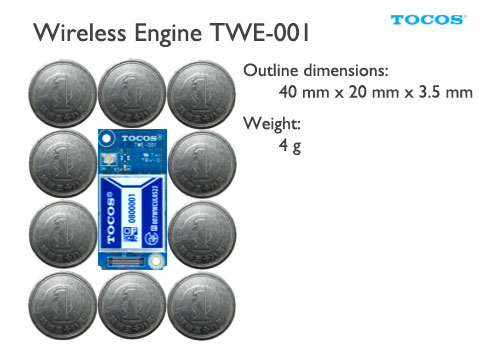 The ZigBee/IEEE802.15.4 Module TOCOS Wireless Engine TWE-001 measures 40 mm x 20 mm x 3.5 mm, very small in size.
The ZigBee/IEEE802.15.4 Module TOCOS Wireless Engine TWE-001 measures 40 mm x 20 mm x 3.5 mm, very small in size.
Compared with 1-yen coin, it is equivalent to one 1-yen coin in width, equivalent to two 1-yen coins in length, and equivalent to four 1-yen coins in weight.
For more detailed outline dimensions, please see Outline and Pinout of TWE-001.
Structure of TWE-001
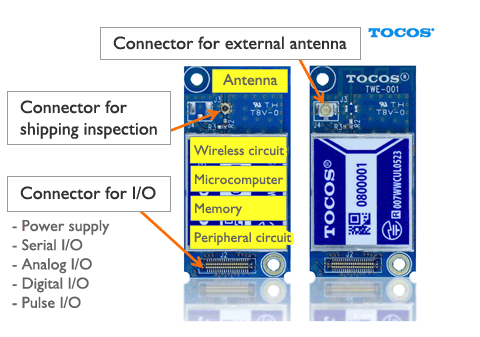 The ZigBee/IEEE802.15.4 Module TOCOS Wireless Engine TWE-001 has integrated a wireless segment compliant with IEEE802.15.4, 32-bit microcomputer part, memory, and a peripheral circuit.
The ZigBee/IEEE802.15.4 Module TOCOS Wireless Engine TWE-001 has integrated a wireless segment compliant with IEEE802.15.4, 32-bit microcomputer part, memory, and a peripheral circuit.
Antenna
There are two types of ZigBee/IEEE802.15.4 Module TOCOS Wireless Engine TWE-001 depending on the antenna used: a built-in antenna type (on the left) and an external antenna connector type (on the right).
The compact built-in antenna performs very well, but using an external antenna will extend the signal range even more. You can choose the antenna type according to your purpose. For various external antennas certified with Technical Regulations, please see product lineup of antennas.
For the specifications of the connector for an external antenna, please see connector for an external antenna.
Connector for shipping inspection
The ZigBee/IEEE802.15.4 Module TOCOS Wireless Engine TWE-001 has a connector on the built-in antenna side, but this is a connector for probing to measure radio output at a shipping inspection. We conduct 100% inspection for radio waves performance at our factory (* Note 1) using a dedicated inspection equipment before shipping.
* Note 1: Certified with ISO9001:2000 (quality management system) and ISO14001:2004 (environmental management system)
Connector for I/O
The ZigBee/IEEE802.15.4 Module TOCOS Wireless Engine TWE-001 is equipped with a 40-pin connector as an external interface so that various I/O signals can be connected, which can keep the number of external circuits around the wireless module at a minimum.
For more details on I/O signals, please see pinout.
The reliability of a connector for connection is very important. To prevent a trouble such as contact failure, tough contact is used here.
- Resistant to vibration and impact.
- Resistant to corrosive gases.
- Not affected by foreign materials getting caught.
- Digital signals are not susceptible to performance deterioration.
As for the information on a 40-pin connector on the reception side, please see connector on the reception side.
The 40-pin connector uses a narrow pitch (0.4 mm). If it is necessary to convert the pitch to 2.54 mm, a conversion board TWE CARRIER is available.
Screw holes for fixing
The ZigBee/IEEE802.15.4 Module TOCOS Wireless Engine TWE-001 can be fixed on a base board with 2 screws. You do not have to worry about coming off due to vibration and impact.
For more information on screws, nuts, and spacers for fixing, please see screws, nuts, and spacers for fixing.
Connection Example of TWE-001
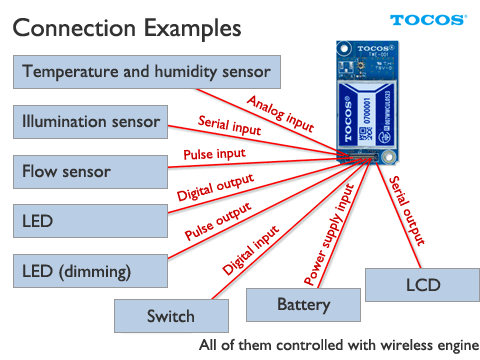 The ZigBee/IEEE802.15.4 Module TOCOS Wireless Engine TWE-001 is a microcomputer module with wireless functions. The CPU is 32-bit RISC and operates at 32 MHz. There are various I/Os equipped that you may find in a general type of microcomputers.
The ZigBee/IEEE802.15.4 Module TOCOS Wireless Engine TWE-001 is a microcomputer module with wireless functions. The CPU is 32-bit RISC and operates at 32 MHz. There are various I/Os equipped that you may find in a general type of microcomputers.
Here is a connection example for the ZigBee/IEEE802.15.4 Module TOCOS Wireless Engine TWE-001. As shown in the illustration, various peripheral devices can be directly connected and controlled. By doing so, peripheral devices can be minimized.
Connect the power supply and sensors to the ZigBee/IEEE802.15.4 Module TOCOS Wireless Engine TWE-001 and put it in a case, then the wireless sensor is completed.
It is possible to conduct all the processing with the microcomputer built in the module so that you can save on additional cost for external microcomputers and memory, or as another option, you can use an external microcomputer and connect it with UART and SPI.
For more details on connecting a peripheral device to the wireless module please see the reference circuit examples.
Implementation Example
 Here is an implementation example of an active RFID tag that uses the ZigBee/IEEE802.15.4 Module TOCOS Wireless Engine TWE-001.
Here is an implementation example of an active RFID tag that uses the ZigBee/IEEE802.15.4 Module TOCOS Wireless Engine TWE-001.
TWE CARRIER 001 (TWE-EK-254CV) is used in the base board. It is driven by CR2032 type button batteries.
Architecture of TWE-001
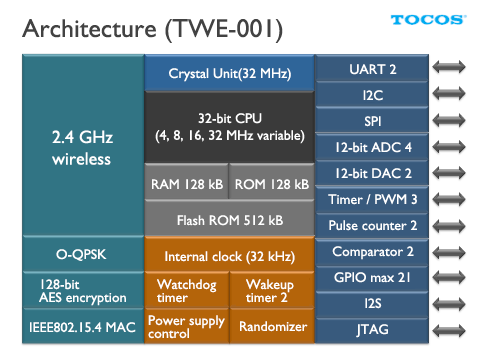 Here is architecture for the ZigBee/IEEE802.15.4 Module TOCOS Wireless Engine TWE-001.
Here is architecture for the ZigBee/IEEE802.15.4 Module TOCOS Wireless Engine TWE-001.
The TOCOS ZigBee/IEEE802.15.4 Module features a wide variety of functions, unlike a single-function wireless modem. The TOCOS Wireless Engine TWE-001 is a highly functional 32-bit microcomputer module that integrates the ZigBee/IEEE802.15.4 wireless function.
A peripheral circuit and memory extension etc. can be structured in the same way as an ordinary microcomputer. The application software is stored in the rewritable flash ROM, expanded in the RAM at the time of start-up and implemented. A boot loader and IEEE802.15.4 MAC are stored in the ROM.
| Microcomputer Part | |
|---|---|
| CPU | 32 bit (4, 8, 16, 32 MHz) |
| ROM | 128 k byte |
| RAM | 128 k byte |
| Flash memory | 512 k byte |
| Functions |
|---|
| 128-bit AES encryption processor |
| Distance measurement from time measurement difference |
| Watchdog timer |
| Randomizer |
| Wakeup timer |
| Voltage monitoring reset circuit |
| Interface | |
|---|---|
| UART | 2 ports |
| I2C (2-line serial) | 1 port |
| SPI | 5 selects |
| AD converter | 12 bit 4 channels |
| DA converter | 12 bit 2 channels |
| Comparator | 2 ports |
| System timer, PWM | 3 ports |
| GPIO (general-purpose digital I/O port ) | Max. 21 ports |
| Pulse counter | 2 ports |
| I2S (4-line audio) | 1 port |
| JTAG terminal | 1 port |
For pinout, please see Outline and Pinout of TWE-001.
Network of TWE-001
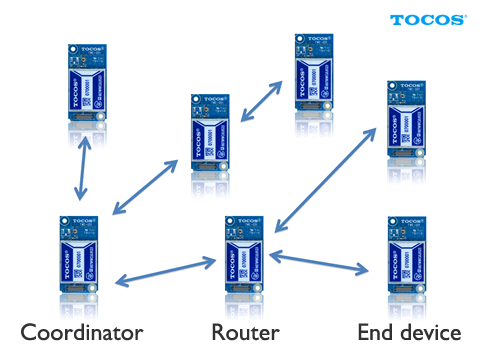 The ZigBee/IEEE802.15.4 Module TOCOS Wireless Engine TWE-001 can be assigned a role of coordinator, router, or end device on the network with common hardware just by changing the software to download in the built-in flash memory.
The ZigBee/IEEE802.15.4 Module TOCOS Wireless Engine TWE-001 can be assigned a role of coordinator, router, or end device on the network with common hardware just by changing the software to download in the built-in flash memory.
Software Implementation Method of TWE-001
The ZigBee/IEEE802.15.4 Module TOCOS Wireless Engine is a microcomputer module that integrates the wireless function, so to operate it, software is required. There are two ways of implementing software. Each has advantages and disadvantages. Make a choice according to your purpose.
Create custom software on your own.
Advantage: You can include whatever functions you want as you like.
Disadvantage: It takes man-hours to develop software.
For the sequence of software development, please see Programming Information.
For the method of using Software Development Environment (SDK), please see ZigBee Development Kit (Introduction).
We make a useful tool for efficient software development, JTAG Debugger (JTAG ICE), available as well.
Use ready-made software.
Advantage: It does not take man-hours to develop software. Prearranged standard functions are available.
Disadvantage: You need to make the product specifications match with the standard functions.
For ready-made software, please see TWE-ZERO series.
Wireless Specifications of TWE-001
Here are wireless specifications for the ZigBee/IEEE802.15.4 Module TOCOS Wireless Engine TWE-001.
| Wireless standard | IEEE802.15.4 |
| Frequency band | 2.4 GHz |
| Number of channels | 16 channels |
| Modulation method | O-PQSK, DSSS |
| Communications Speed | 250 kbps (IEEE802.15.4) / 500 kbps / 667 kbps |
| Transmission output | +2.7 dBm (25 C, 3V, Typ, SWG connector) |
| Receiving sensitivity | -95 dBm (25 C, 3V, Typ, SWG connector) |
| Encryption | AES-128 bit |
| Certificate for radio waves | ARIB-STD-T66 Factory Design Certificate (Technical Regulations Conformity Certification) AS/NZS 4268 |
Power Consumption (Current) of TWE-001
One of the features of the TOCOS Wireless Engine TWE-001 is super low power consumption.
To realize low power consumption as an ZigBee/IEEE802.15.4 Module, it is imperative to suppress consumption current at each processing, but it is equally important to shorten the start-up and processing time. If it takes time to process, it will eventually consume large electricity even with small consumption current at a unit time.
The ZigBee/IEEE802.15.4 Module TOCOS Wireless Engine TWE-001 has achieved super low power consumption with the class world' s lowest current consumption, instantaneous start-up, and high-speed processing.
Example of power consumption at temperature measurement
(consumption current)
Here is an example of power consumption (consumption current) of the ZigBee/IEEE802.15.4 Module TOCOS Wireless Engine TWE-001 from the time of starting up from the sleep state to reading the data from a temperature sensor to starting communications.
The example has been measured in the application where the temperature sensor data created with the use of IEEE802.15.4 API are transmitted. The measurement results include the power consumption (current consumption) for all of the wireless segment, the microcomputer part, and the sensors.
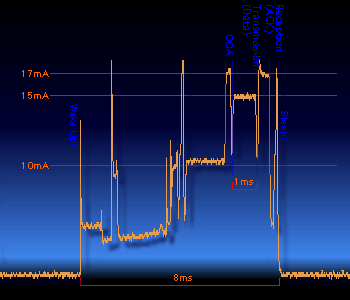
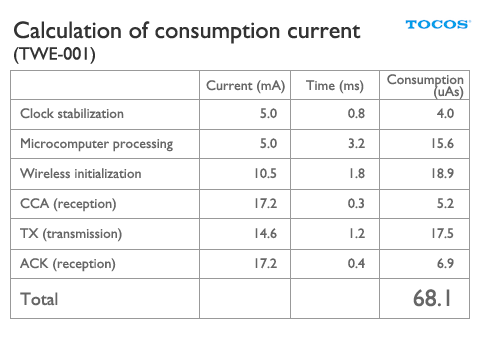 In the first half of the diagram, the processing is underway, such as start-up of the microcomputer and obtaining the temperature sensor data. You can see that CPU starts running within 1 msec. Then, the wireless circuit starts up and implements CCA (clear channel assessment) in the reception state, followed by the consumption current during packet transmission. In addition, the receiving circuit is also at work to receive acknowledgement ACK from the transmission destination. Whether to implement the acknowledgement or not after sending data can be chosen depending on the purpose of the application.
In the first half of the diagram, the processing is underway, such as start-up of the microcomputer and obtaining the temperature sensor data. You can see that CPU starts running within 1 msec. Then, the wireless circuit starts up and implements CCA (clear channel assessment) in the reception state, followed by the consumption current during packet transmission. In addition, the receiving circuit is also at work to receive acknowledgement ACK from the transmission destination. Whether to implement the acknowledgement or not after sending data can be chosen depending on the purpose of the application.
The data transmission time is proportional to the amount of data to be sent.
Calculation of current consumption
Since with ZigBee/IEEE802.15.4, it transmits at a communications speed of 250 kbps, so it takes about 4 ms to send the maximum packet size of 127 byte. In this example, it sends about 32 byte (with ACK) with header included.
The data transfer speed for ZigBee/IEEE802.15.4 is 250 kbps. You can obtain the transfer time to send 1 data frame using the following equation.
Header size = 15 - 31 byte
Data size = 1 - 112 byte
Data transfer time (ms) = (Header size + Data size) × 8 / 250
During the transfer, 14.6 mA current will be flowing.
The wireless module boasts the very short processing time of only 5 msec - 10 msec to complete the sequence from the reception of ACK to getting back to the sleep state including the microcomputer processing. (The time depends on the processing contents of the application software and the amount of data to be sent and received. In this case, it is 8 msec.)
In the above example, let' s say 1 transmission is processed in every 10 seconds, it will consume about 20 - 25 μA current on average, which means a compact battery of 220 mAh (equivalent to CR2032 button battery) will last for a year, and alkaline batteries of 900 mAh (equivalent to 2 AAA batteries) will last for 5 years. (* The lifetime of batteries will vary depending on the usage conditions: Pulsing load [generally improve the lifetime], Momentary overload current [decline the lifetime], Temperature conditions [decline the lifetime at high temperature, voltage drop at low temperature]. For more details, please refer to the characteristics of the batteries in use. You should pay special attention to possible voltage drop in the batteries with high internal resistance.)
Example of power consumption (current consumption) when used as an active RF tag
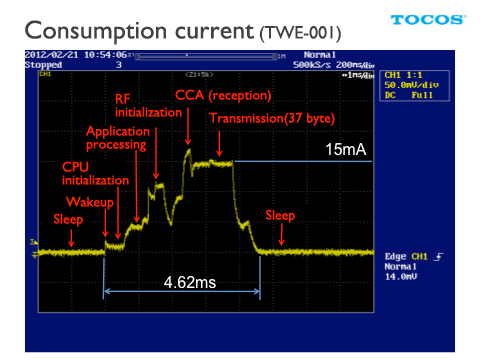 The next one shows a usage example as an RF tag. In this example, a sensor is not used and the ID data of 37 byte are periodically sent with the built-in timer. There is no acknowledgement (ACK) from the transmission destination. The average consumption current to send 1 packet is 8.15 mA with a processing time of 4.62 msec.
The next one shows a usage example as an RF tag. In this example, a sensor is not used and the ID data of 37 byte are periodically sent with the built-in timer. There is no acknowledgement (ACK) from the transmission destination. The average consumption current to send 1 packet is 8.15 mA with a processing time of 4.62 msec.
Here is a lifetime of a battery when a coin type battery (CR2032) is used. The capacity of a battery is calculated with 220 mAh. According to the calculation, it will last for a year if it sends data in the interval of 2 seconds, and over 3 years if in the interval of 30 seconds.
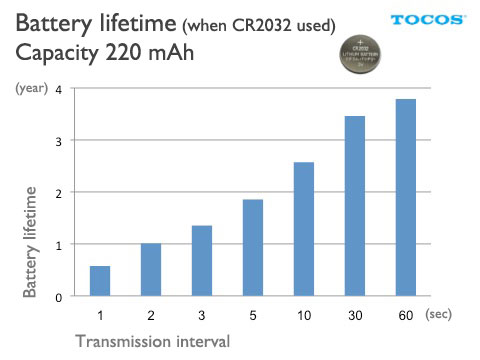
Here is a lifetime of a battery when 2 AAA alkaline batteries are used. The capacity of a battery is calculated with 900 mAh. It will last for over 10 years if it sends in the interval of 10 seconds.
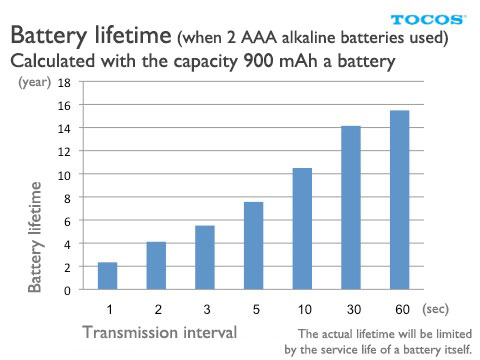
Here is a lifetime of a battery when 2 D alkaline batteries are used. The capacity of a battery is calculated with 12500 mAh. It will last for about 100 years if it sends in the interval of 5 seconds, and over 200 years if in the interval of 60 seconds. This is just a calculation value, and no battery can be used for such a long time. The recommended usage time for a battery is generally 5 to 10 years.
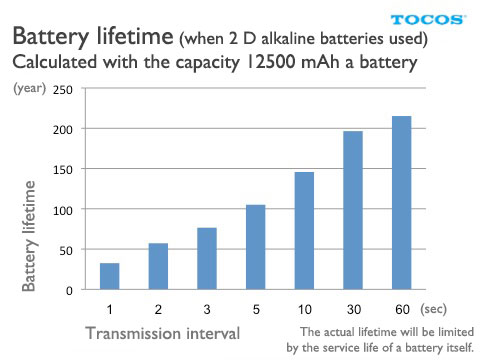
As proven in those data, TWE-001 is an ZigBee/IEEE802.15.4 Wireless Module that operates at super low power consumption. It can even run on the electricity gained from a harvester (generator) that uses energy harvesting technologies.
Signal Range of TWE-001
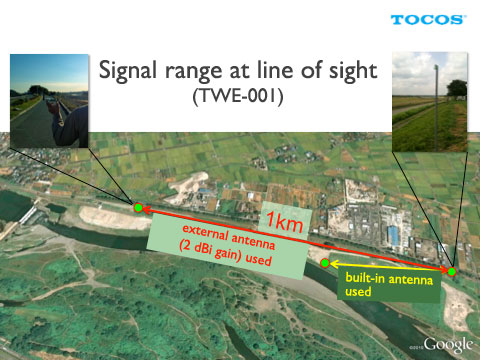 Another feature of the ZigBee/IEEE802.15.4 Module TOCOS Wireless Engine TWE-001 is the signaling performance.
Another feature of the ZigBee/IEEE802.15.4 Module TOCOS Wireless Engine TWE-001 is the signaling performance.
This is the measurement results to find out the maximum signal range for the ZigBee/IEEE802.15.4 Module TOCOS Wireless Engine TWE-001.
With propagation of radio waves influenced by various conditions, the signal range will also vary. Therefore, the measurement in a straight-line distance at line of sight in the environment with very little noise is often cited as a performance indicator of a communications module. From the measurement, the actual performance value of link budget (the budget for connecting communications) can be obtained.
While maintaining low power consumption, the ZigBee/IEEE802.15.4 Module TWE-001 achieves excellent reach of up to 400 m at line of sight with a built-in antenna, and 1 km (* 1) with an external antenna (2 dBi gain, non-directional). In this way, the ZigBee/IEEE802.15.4 Module TWE-001 has secured substantial link budget while compliant with the Radio Act of Japan. Using a directional antenna of higher gain can make the signal range even longer.
The measurement can also be used to check whether a product is actually according to the design specifications or not. (Any defect in high-frequency circuit design or manufacturing processes will result in much lower link budget.)
Here are equations to determine a theoretical value of a signal range in free space.
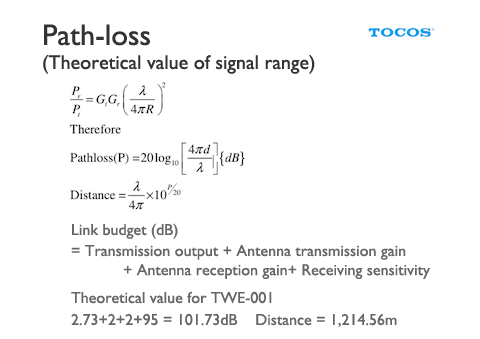
The link budget (dB) for the ZigBee/IEEE802.15.4 Module TWE-001 is 101.73 dB when a 2 dBi antenna is used. According to the above equations, the theoretical value of a signal range in free space for the ZigBee/IEEE802.15.4 Module TWE-001 (when a 2dBi antenna used) is 1,214.56 m.
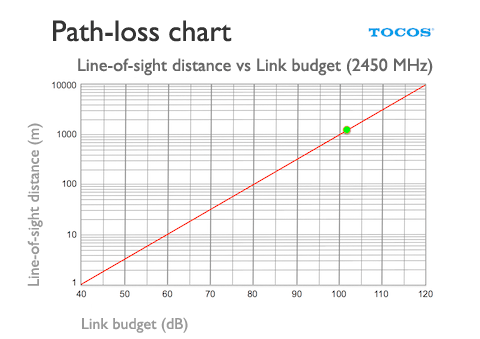
According to the path-loss chart, a link budget of over 100 dB corresponds to the theoretical signal range of over 1,000 m, thus enabling us to say that the actual measurement is valid. If a theoretical value and an actual signal range turn out to be largely different, some defect may exist in its design or manufacturing processes. This must have proven to you that a high level of analog circuit design and quality control is applied to the ZigBee/IEEE802.15.4 Module TOCOS Wireless Engine TWE-001 as a wireless module.
Because of the characteristics of radio waves, the signal range will be shorter indoors and where there are obstacles, but the ability to perform long signal range at line of sight (i.e. large link budget) contributes to extending the distance indoors and where there are obstacles as well. The point is that how much budget is left after spending it with obstacles. If a budget enough for communications is left, it can communicate. Thus, the performance of the ZigBee/IEEE802.15.4 Module that enables long signal range at line of sight is very important to obtain stable communications in other kinds of conditions. Even where you do not need such a great reach, the product offers more stable communications, allowing you to enhance the reliability of a system.
The signal range of the ZigBee/IEEE802.15.4 Module TWE-001 will vary depending on the difference in conditions such as obstacles and noise, just like other ordinary wireless modules. An actual distance may differ from the measurement results depending on the difference in conditions such as obstacles and noise. In designing application, it is recommended to use the Communications Quality Measurement Tool that comes with the ZigBee/IEEE802.15.4 Module Evaluation and Development Kit, and measure a distance in the actual environment where you intend to use the product.
* 1: When measured with a non-directional external antenna of 2 dBi gain, with little impact of extraneous noises, at line of sight distance.
Radiation Pattern of TWE-001 Built-in Antenna
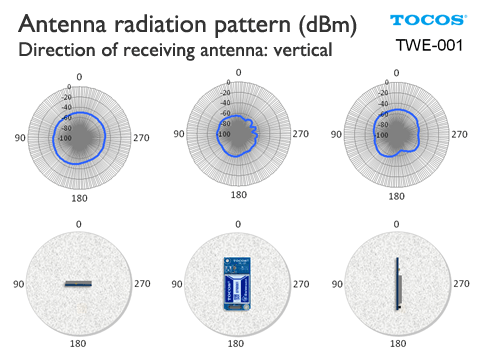 This is the radiation pattern of the built-in antenna of the ZigBee/IEEE802.15.4 Module TOCOS Wireless Engine TWE-001.
This is the radiation pattern of the built-in antenna of the ZigBee/IEEE802.15.4 Module TOCOS Wireless Engine TWE-001.
When using the built-in antenna, please refer to Guideline for built-in antenna.
Use of Product outside of Japan
To use the ZigBee/IEEE802.15.4 Module TOCOS Wireless Engine TWE-001 outside of Japan requires certification according to the radio law of the country. For assistance, please contact us.
To export the ZigBee/IEEE802.15.4 Module TOCOS Wireless Engine TWE-001 outside of Japan, it is necessary to determine whether the product is applicable or not according to the Foreign Exchange and Foreign Trade Act and relevant acts (e.g. Foreign Exchange and Foreign Trade Control Law). If you need a compliance certificate, please contact us.
Materials
- TWE-001 Brochure Japanese version English version
- Wallpaper (960 x 480) Japanese version English version
Related Products
- ZigBee/IEEE802.15.4 Evaluation and Development Kit
- Sensor Network Evaluation Kit
Wireless Products
- Overview
- Wireless Products Overview
- Wireless Engine
- TWE Lite DIP
- TWE-Lite
- TWE-REGULAR
- TWE-STRONG
- Software
- ToCoNet
- TWE-ZERO
- Evaluation, Development
- Evaluation & Development Kit
- Sensor Network Evaluation Kit
- Antenna
- Avaliable Antennae
Technical Information
- RFID
- 920MHz_vs_24
- IEEE802.15.4
- Protocol Stack
- ZigBee
- Wireless Sensor Networks
- Energy Harvesting Technology
- M2M Wireless Communications
- HEMS / BEMS / FEMS / CEMS
- Internet of Things

